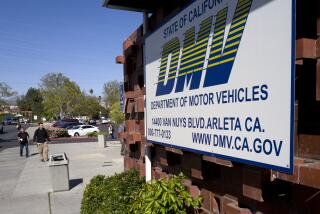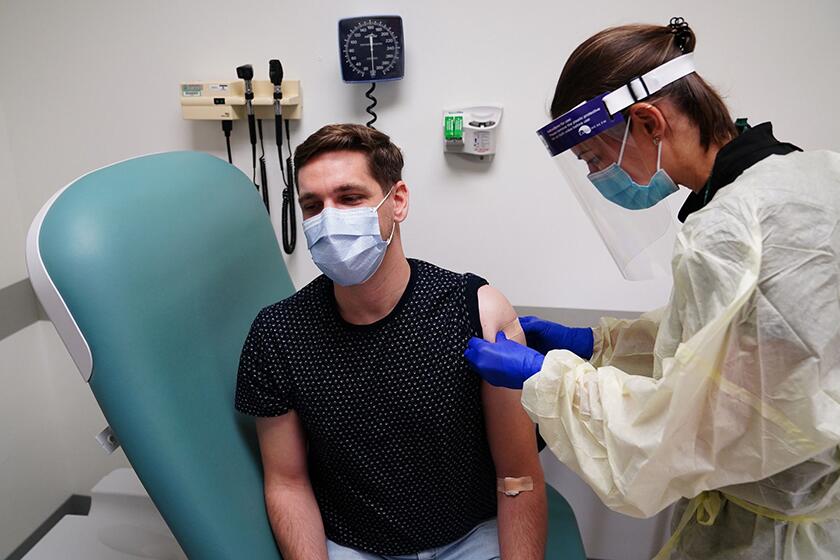Op-Ed: Self-driving cars could keep seniors in the driver’s seat
- Share via
My Grandma Bobbie is 93 and lives on her own, in a spotless condo decorated with enviable midcentury furnishings. The daughter of a General Motors millwright, she grew up in Detroit riding the streetcar, but one of her goals was to get to the promised land — the suburbs — and preferably by car.
For my grandmother, like many older people in her cohort, a car is not only a convenience or a luxury — though it is that; Grandma loved Lincolns and Cadillacs and now drives a Lexus — it is a lifeline, the only way to make regular trips to the store, to visit with family or to attend medical appointments.
Her best friend, Evelyn, who is 97 and still in excellent health, gave up her car last year after a few traffic incidents and immediately had to move into an apartment in an assisted living facility. Evelyn is cheery and social and has enjoyed the change — she loves not having to cook for herself.
But my grandmother is far more reserved and fiercely independent. When I asked her about the assisted living site, she told me, “Evelyn says I’d hate it.” I’m certain Evelyn is right.
But there will soon be another option. Science-fiction fears of a robot takeover aside, the self-driving car is now within reach. And while a fully autonomous vehicle may not be ideal for all — for example, auto journalists/enthusiasts like me, for whom exploring a car’s capabilities is both enjoyable and a professional mandate — access to one may allow seniors like my grandma to maintain their sense of self, their pride and their elaborate hairdos. (Not a joke: Forgoing personal hygiene, even in the form of weekly trips to what Bobbie calls her “beauty operator,” can be a symptom of or catalyst to mental and physical decline.)
The self-driving car may also allow us to reduce the risk that older drivers pose to themselves and others, Mr. Magoo-ing about our roadways. As physical and mental degeneration occurs and reaction times slow, aging drivers can lose faith in their abilities or find their capacities fail them. As you may have surmised from exasperating personal experience, metered freeway onramps, the porte-cochere at the Beverly Hills Hotel, intersections and yield lanes pose a particular challenge.
And then there’s the risk factor. According to the Insurance Institute for Highway Safety, the collision rate for older drivers is among the highest of any age group. Seniors are surpassed only by teenagers and entitled millennials when it comes to per capita insurance damage claims. And older drivers have one of the highest rates of traffic fatalities per mile driven, in part because they lack resilience to recover from injuries sustained.
Lest you think this is a niche problem concentrated among cravat-wearing Buick pilots in Palm Springs, think again. Between now and 2020, the California population of seniors is projected to grow at a rate twice as fast as the state’s total population.
Among the oldest subset of this demographic, that increase is expected to jump more than 300% in several counties, nearly all of them far from the density and public transport offered in urban areas. And that’s before the lurking glut of baby boomers starts to turn 85 around 2030. By then, up to a quarter of the nation’s licensed drivers will be older than 85.
A fully autonomous vehicle, with a constant 360-degree range of view and instantaneous response times, will act faster and more accurately than the average human — and certainly faster and more accurately than my grandma’s few remaining friends — keeping everyone on the road safer.
Insurance Institute for Highway Safety studies have indicated that emergent crash-avoidance features, such as autonomous braking, significantly reduce collisions and claims. Studies have also shown that fragile senior drivers not only benefited from existing safety technologies, such as side air bags and automatically adjusting seat belts, they are open and adaptable to new technology like backup cameras.
The arrival of the fully autonomous car is imminent. After Gov. Jerry Brown signed SB 1298 into law in 2012 to allow such vehicles to operate on California roads, the Department of Motor Vehicles set to work crafting rules for their manufacture and operation. Draft regulations will be complete by early July. Written public comment will follow, with public hearings in August before finalized rules are submitted by Jan. 1.
Major mass-market manufacturers such as Nissan and General Motors are watching California, and its nearly 25 million licensed drivers, and have indicated that they’re aiming to bring fully autonomous vehicles to market before the decade’s end.
One of the key tenets in the California State Plan on Aging for 2013-17 is to “advance the availability of transportation services that are responsive to the needs of older adults.” Once autonomous cars meet safety standards, they can help serve these ends.
If Grandma Bobbie ever starts to decline — and she’s still gorgeous and in perfect health, so that’s a big if — I’ll be pulling for her to buy one. Though the last time I tried to get her to buy a new car, she said, “I’m in my 90s now. Maybe I’ll lease?”
Brett Berk’s automotive writing appears regularly in Vanity Fair, Details, GQ, Road & Track, Popular Mechanics and Yahoo! Autos. Twitter: @StickShift_VF
More to Read
A cure for the common opinion
Get thought-provoking perspectives with our weekly newsletter.
You may occasionally receive promotional content from the Los Angeles Times.









